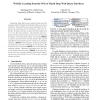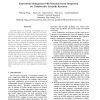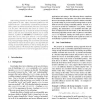ICDE
2006
IEEE
15 years 27 days ago
2006
IEEE
In this paper, we present the ArchIS system that achieves full-functionality transaction-time databases without requiring temporal extensions in XML or database standards. ArchIS&...
ICDE
2006
IEEE
15 years 27 days ago
2006
IEEE
Most previously proposed frequent graph mining algorithms are intended to find the complete set of all frequent, closed subgraphs. However, in many cases only a subset of the freq...
ICDE
2006
IEEE
15 years 27 days ago
2006
IEEE
The high quality, structured data from Web structured sources is invaluable for many applications. Hidden Web databases are not directly crawlable by Web search engines and are on...
ICDE
2006
IEEE
15 years 27 days ago
2006
IEEE
Updates over virtual XML views that wrap relational data are not well supported by XML data management systems. This paper studies the problem of whether a correct relational upda...
ICDE
2006
IEEE
15 years 27 days ago
2006
IEEE
Integrating Deep Web sources requires highly accurate semantic matches between the attributes of the source query interfaces. These matches are usually established by comparing th...
ICDE
2006
IEEE
15 years 27 days ago
2006
IEEE
Scientific research is becoming increasingly relied on collaborative effort among multiple institutions and interdisciplinary consortium, through sharing experiments and data, and...
ICDE
2006
IEEE
15 years 27 days ago
2006
IEEE
Data mining promises to discover valid and potentially useful patterns in data. Often, discovered patterns are not useful to the user. "Actionability" addresses this pro...
ICDE
2006
IEEE
15 years 27 days ago
2006
IEEE
Graph reachability is fundamental to a wide range of applications, including XML indexing, geographic navigation, Internet routing, ontology queries based on RDF/OWL, etc. Many ap...
ICDE
2006
IEEE
15 years 27 days ago
2006
IEEE
Existing graph mining algorithms typically assume that databases are relatively static and can fit into the main memory. Mining of subgraphs in a dynamic environment is currently ...
ICDE
2006
IEEE
15 years 27 days ago
2006
IEEE
XML schema design has two opposing goals: elimination of update anomalies requires that the schema be as normalized as possible; yet higher query performance and simpler query exp...




